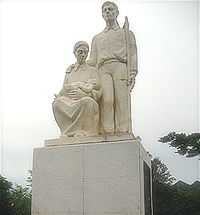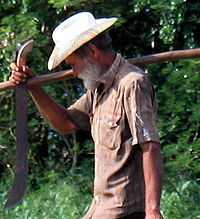Jíbaro
| Jíbaro | |
|---|---|
 Monumento al Jíbaro Puertorriqueño dedicated to the Jíbaro, in Salinas, Puerto Rico. | |
| Nationality | Puerto Rican |
| Ethnicity | European, Taíno and Afro-Caribbean |
| Occupation | Agricultural land tenants, sharecroppers, fieldworkers |
| Religion | Catholic, Protestant |
Jíbaro is a term commonly used in Puerto Rico to refer to mountain-dwelling peasants,[1] but in modern times it has gained a broader and, specifically, a nobler, cultural meaning.[2]
History

In Puerto Rico, the Jíbaro culture has its origins in the Native Taino culture and the term Jíbaro usually refers to "La Gente de la Montañas" (the people of the interior mountainous regions of Puerto Rico) and emerged in the 16th century with the blending of the Pre-Columbian Native Taino and Spanish European cultures in the central mountains of the island of Puerto Rico. Some elements of the jíbaro culture are still visible today. For example, when Luis Muñoz Marín founded the Popular Democratic Party (PDP) in 1938, the party adopted the jíbaro hat, the pava, as its symbol. The PDP seal shows the pava with the words "Pan, Tierra, y Libertad", which translates to "Bread, Land, and Freedom". Also, every Christmas, Puerto Ricans use the Jíbaro instruments, music, and cuisine to celebrate these festivities.

The first known use of the word "jíbaro" occurred in 1814 in Diario Económico de Puerto Rico. In that paper there is a letter to the editor dated 17 June 1814 signed by “El Gíbaro Paciente” (The Patient Jíbaro). It is used in the context of an indigenous Puerto Rican character.[3]
Modern usage of the word
Since at least the 1920s,[4] the term Jíbaro has a more positive connotation in Puerto Rican culture, proudly associated with a cultural ideology as pioneers of Puerto Rico.[5]
However, the term occasionally also has a negative connotation. A jíbaro can mean someone who is considered ignorant or impressionable due to a lack of a more European style of education. Despite this negative connotation, the image of the jíbaro represents an ideology of a traditional Puerto Rican: hard-working, simple, independent, and prudently wise.[6]
Colloquially, the jíbaro imagery serves as a representation of the roots of modern Puerto Rican people, and symbolizes the strength of traditional values of living simply and properly caring for homeland and family.[7]
Uses of the word in other countries
- In Cuba there exists a word similar to jíbaro, Guajiro. In Cuba and Dominican Republic, a jíbaro is a runaway dog.[8]
- In Colombia, Brazil and Venezuela, Xivaro, or Gibaro, which is pronounced similar to jíbaro, was a name given to the natives of Colombia, Brazil and Venezuela by the Spaniards and Portuguese.[9]
- In Ecuador, givaro is the indomitable Indigenous person that is endlessly elusive to the white man.[10]
- In 18th-century Mexico, a jíbaro was the child of a lobo and a china, that is the child of a mixed-race father (the son of an Indigenous man and a black woman) and a mixed-race mother (the daughter of a white man and an Indigenous woman).[11]
Further reading
- El Jibaro. Puerto Rico Off The Beaten Path. Page 157. Accessed January 16, 2011.
Notes and references
- ↑ Enrique Vivoni Farage and Sylvia Alvarez Curbelo. Hispanofilia: Arquitectura y Vida en Puerto Rico, 1900-1950. San Juan, Puerto Rico: Editorial de la Universidad de Puerto Rico. 1998. Page 258. ISBN 0-8477-0252-9.
- ↑ Tijana Ilich. Puerto Rican Music - Jíbaro Music - Seis, Aguinaldo, Bomba, Plena. About.com
- ↑ El Silenciamiento del Sujeto de Origen Africano en las Letras Puertorriqueñas del Siglo XIX. Rosita E. Villagómez. Florida State University. School of Arts and Sciences. Ph.D. dissertation. Department of Modern Languages and Linguistics. Summer 2005. Page 46. Retrieved 25 July 2012.
- ↑ Puerto Rico, Antonio Paoli y España: Aclaraciones y Críticas. Néstor Murray-Irizarry. Footnote #26 (José A. Romeu, "Recordando noches de gloria con el insigne tenor -Paoli", El Mundo, 31 de noviembre de 1939. p. 13) Ponce, Puerto Rico. Retrieved 27 April 2013.
- ↑ ¡Un agricultor de nueve años de edad! Carmen Cila Rodríguez. La Perla del Sur. Ponce, Puerto Rico. 27 July 2011. Retrieved 12 October 2011.
- ↑ ¡Un agricultor de nueve años de edad!: Carlos Emanuel Guzman, un jibaro de nueva estirpe. Carmen Cila Rodríguez. La Perla del Sur. Ponce, Puerto Rico. Year 29, Issue 1443. 27 July 2011. Page 6. Retrieved 4 November 2011.
- ↑ ¡Un agricultor de nueve años de edad!: Carlos Emanuel Guzman, un jibaro de nueva estirpe. Carmen Cila Rodríguez. La Perla del Sur. Ponce, Puerto Rico. Year 29, Issue 1443. 27 July 2011. Page 6. Retrieved 4 November 2011.
- ↑ Enrique Vivoni Farage and Sylvia Alvarez Curbelo. Hispanofilia: Arquitectura y Vida en Puerto Rico, 1900-1950. San Juan, Puerto Rico: Editorial de la Universidad de Puerto Rico. 1998. Page 258. ISBN 0-8477-0252-9.
- ↑ Maurizio Gnerre. Jivaroan linguistic and cultural tradition: an Amazonian-Andean sedimentation (Word Document). Università degli Studi di Pavi
- ↑ Enrique Vivoni Farage and Sylvia Alvarez Curbelo. Hispanofilia: Arquitectura y Vida en Puerto Rico, 1900-1950. San Juan, Puerto Rico: Editorial de la Universidad de Puerto Rico. 1998. Page 258. ISBN 0-8477-0252-9.
- ↑ Enrique Vivoni Farage and Sylvia Alvarez Curbelo. Hispanofilia: Arquitectura y Vida en Puerto Rico, 1900-1950. San Juan, Puerto Rico: Editorial de la Universidad de Puerto Rico. 1998. Page 258. ISBN 0-8477-0252-9.